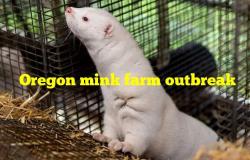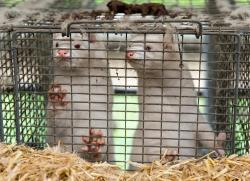 State Senate bill 832, introduced by Senator Floyd Prozanski (D-Eugene), would phase out mink farming in Oregon within a year of enactment with compensation to the five remaining mink pelt producers.
State Senate bill 832, introduced by Senator Floyd Prozanski (D-Eugene), would phase out mink farming in Oregon within a year of enactment with compensation to the five remaining mink pelt producers.
This is the first bill aimed directly at mink production in the U.S. and follows action taken by Denmark and the Netherlands. Following the emergence of SARS-CoV-2 in mink in Denmark, intensive surveillance was initiated revealing the presence of a variant subsequently isolated from human contacts on farms and in distant communities.
 The Netherlands, previously the World’s fourth largest mink producer, has banned all fur farming bringing forward the date to cease production. This action was taken on the basis of a high infection rate among mink farmers and their families in the nation.
The Netherlands, previously the World’s fourth largest mink producer, has banned all fur farming bringing forward the date to cease production. This action was taken on the basis of a high infection rate among mink farmers and their families in the nation.
Although extensive outbreaks have occurred among mink farms in Utah, Wisconsin, Oregon, and possibly other states, there has been no federal intervention and state departments of agriculture have tended to protect their mink producers minimizing risks of COVID to the human population and concealing epidemiologic data. EGG-NEWS has previously documented the spurious and misleading statements by spokespersons representing the Oregon Department of Agriculture with regard to incidence, location and significance of COVID in mink.
 The hearing on Oregon Senate SB832 involved testimony by Dr. James Keen. He was previously a USDA veterinary epidemiologist with extensive experience dealing with epidemics of animal disease including foot-and-mouth outbreaks in the UK in 2001 and African swine fever in Asia. Since his retirement from the USDA Dr. Keen has been an outspoken opponent of intensive livestock production and is allied with activist organizations including serving as a whistle blower exposing irregularities at the USDA U.S. Meat Animal Research Center (MARC) in Nebraska in 2015.
The hearing on Oregon Senate SB832 involved testimony by Dr. James Keen. He was previously a USDA veterinary epidemiologist with extensive experience dealing with epidemics of animal disease including foot-and-mouth outbreaks in the UK in 2001 and African swine fever in Asia. Since his retirement from the USDA Dr. Keen has been an outspoken opponent of intensive livestock production and is allied with activist organizations including serving as a whistle blower exposing irregularities at the USDA U.S. Meat Animal Research Center (MARC) in Nebraska in 2015.
Some of the testimony Dr. Keen presented is valid in that mink are the only farmed animals that are extremely susceptible to COVID and are capable of infecting humans. In addition there is evidence that escape of mink from farms could result in exposure of wildlife to COVID with the potential of creating a reservoir of infection. That mink are susceptible to COVID is understandable in that a closely related species, the ferret, is used as a research model for a range of human infections including coronaviruses and orthomyxoviruses.
Dr. Keen is however stretching scientific reality by implicating mink farming as a possible link between bat coronaviruses in China and the emergence of COVID.
This commentator does however agree with Dr. Keen that a vaccine against COVID-19 for mink, even if approved by USDA on the basis of efficacy and safety, will not ameliorate risk. Widespread application of a specific vaccine in a highly susceptible species and may complicate the issue of mink-related COVID by exerting evolutionary pressure on the virus resulting in the possible emergence of variants.
If mink were a critical food producing animal or had some purpose other than contributing to an outmoded and now discredited fashion, there may be some justification for perpetuating production. The risk of COVID and the obvious opposition to confinement of a sentient mammal suggests that mink farming in industrialized nations such as the U.S and in the E.U. is an anachronism. It is time that legislators recognize that the interests of the population at large far exceeds the personal benefits enjoyed by the few remaining mink farmers in a limited number of states. The U.S. should follow the example of European nations and eliminate this unnecessary agricultural activity. Unique among farmed animals mink are involved in a disease that has plunged the U.S. into the worst public health crisis of the past century and has directly and indirectly cost trillions of dollars. Mink production is not even a rounding factor in U.S. agriculture and probably contributes less to the economy than puppy mills.